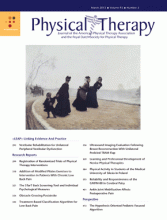Abstract
Background A treatment-based classification algorithm for low back pain (LBP) was created to help clinicians select treatments to which people are most likely to respond. To allow the algorithm to classify all people with LBP, additional criteria can help therapists make decisions for people who do not clearly fit into a subgroup (ie, unclear classifications). Recent studies indicated that classifications are unclear for approximately 34% of people with LBP.
Objective To guide improvements in the algorithm, it is imperative to determine whether people with unclear classifications are different from those with clear classifications.
Design This study was a secondary analysis of data from 3 previous studies investigating the algorithm.
Methods Baseline data from 529 people who had LBP were used (3 discrete cohorts). The primary outcome was type of classification, that is, clear or unclear. Univariate logistic regression was used to determine which participant variables were related to having an unclear classification.
Results People with unclear classifications had greater odds of being older (odds ratio [OR]=1.01, 95% confidence interval [CI]=1.003–1.033), having a longer duration of LBP (OR=1.001, 95% CI=1.000–1.001), having had a previous episode(s) of LBP (OR=1.61, 95% CI=1.04–2.49), having fewer fear-avoidance beliefs related to both work (OR=0.98, 95% CI=0.96–0.99) and physical activity (OR=0.98, 95% CI=0.96–0.996), and having less LBP-related disability (OR=0.98, 95% CI=0.96–0.99) than people with clear classifications.
Limitations Studies from which participant data were drawn had different inclusion criteria and clinical settings.
Conclusions People with unclear classifications appeared to be less affected by LBP (less disability and fewer fear avoidance beliefs), despite typically having a longer duration of LBP. Future studies should investigate whether modifying the algorithm to exclude such people or provide them with different interventions improves outcomes.
Footnotes
All authors provided concept/idea/research design and data collection. Dr Stanton, Dr Hancock, Dr Apeldoorn, and Dr Wand provided writing. Dr Stanton and Dr Wand provided data analysis. Dr Stanton provided project management, facilities/equipment, and institutional liaisons. Dr Stanton, Dr Hancock, Dr Wand, and Dr Fritz provided fund procurement. Dr Stanton, Dr Wand, and Dr Fritz provided study participants. Dr Wand and Dr Fritz provided consultation (including review of manuscript before submission). The authors thank Nate Savage, Anne Thackeray, Faris al-Odaibi, Mohammed Qasheesh, and Jake Magel for help in recoding data.
This project was supported by a Physiotherapy Research Foundation tagged Physiotherapists' Registration Board of Western Australia research grant. Dr Stanton was supported by a Canadian Institutes of Health Research Postdoctoral Training Fellowship (ID 223354).
- Received June 26, 2012.
- Accepted November 2, 2012.












